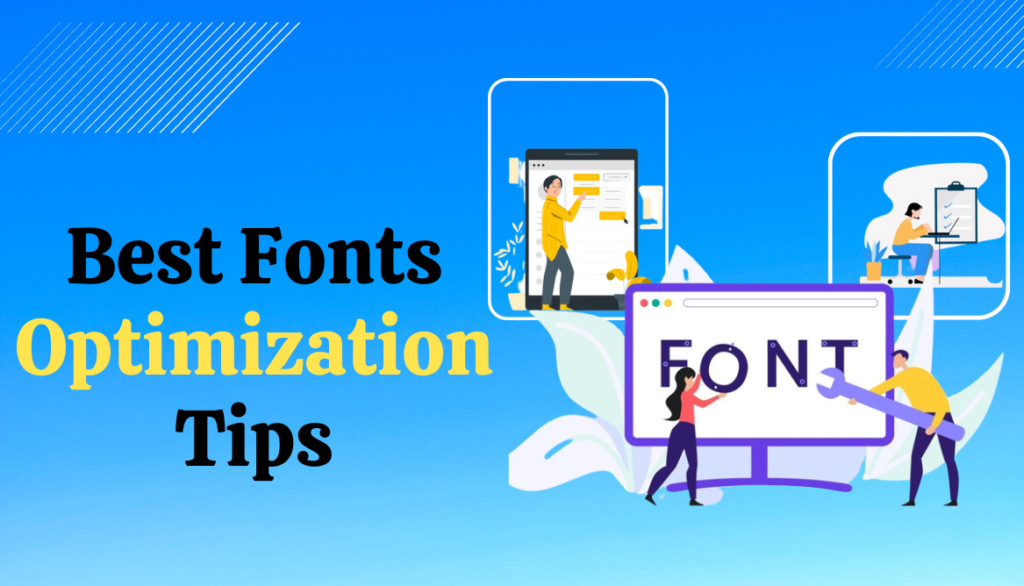Web fonts are the fonts especially created for websites. The type of typography you implement has to make your content readable, and user-friendly. With the use of web fonts, however, site owners often experience a great reduction in speed and performance. There comes web font optimization for the rescue.
Each font you use adds a bit more time to page loading. Therefore, each font you use needs to be optimized. Optimizing web fonts not only boosts page speed but also helps reduce total page size and improve the core web vitals, especially the CLS metric.
In this article, we are providing the best ways to help you know how web font optimization helps in website performance
How to Optimize Web Fonts for a Faster Website
Clearly, optimizing for fonts is an essential step in your website development process. But web font optimization is a complex process and needs a thorough knowledge of the topic to be performed precisely. While there are different ways of optimizing web fonts, the way you optimize fonts depends on your hosting preferences, the site’s design and server, and how deep you want to go to improve the performance of your fonts.
Before you start optimization, you’ll need to know how many fonts you are using. Speed testing tools such as GTmetrix and Pingdom can help you with this.
Here we describe ways to optimize web fonts that will help you instantly boost the appeal and performance of your WordPress site.
1- Audit and Monitor Font Use
Auditing for web fonts can help you know more about them. The use of custom fonts has increased throughout the years after the rule of CSS @font-face is supported by the browser. According to the HTTP Archive, 67% of the web pages are using custom fonts and websites with an average of four font HTTP requests.
It is best and recommended to keep the fonts as minimum as two – one for your headings and one for body copy. Minimizing the number of web fonts not only helps you reduce the overall number of HTTP requests but makes your web design more effective.
On the other site, websites having lots of colors, fonts & other elements lower the quality of user experience.
The font variations such as italics, or bold also add to the file size and page weight. Therefore, it is important to take into account these variations when optimizing for fonts and avoid using the ones that are of no value.
2- Subset Font Resources
Many fonts can be a subset or even split into multiple Unicode ranges to deliver only the characters needed for a particular page.
Using @font-face, you can use the Unicode range descriptor to specify a list of range values, which can be set out in three different forms:
- Single codepoint: indicates a single character
- Interval range: indicates the start and end codepoints of a range of characters.
- Wildcard range: characters indicate any hexadecimal digit.
It’s important to optimize for font reuse when defining subsets. For instance, don’t download a different by an overlapping set of characters on each page. It’s good practice to subset based on a script, such as Latin, Cyrillic, etc.
If the purpose of a Google Webfont is displaying your site title, then it would be better to only download specific characters used in the title. Simply add &text= followed by the specific letters you wish to download at the end of a Google fonts URL.
3- Use modern font formats
There are four font container formats in use on the web: EOT, TTF, WOFF, and WOFF2.
- Embedded Open Type (EOT): Microsoft designed this format, which is now only used by IE browsers.
- True Type Font (TTF): it’s been around since the late 1980s that provides partial IE support.
- Web Open Font Format (WOFF): this format is developed in 2009, which is essentially OpenType or TrueType with compression and additional metadata. While it offers great support but it is not available in some older browsers.
- Web Open Font Format (WOFF2): an improvement on WOFF provides a 30% reduction in file size on average.
4- Implement Cookies
Cookies can help you store fonts of a website so that the browser doesn’t have to download them over and over again. Since the fonts are present in the browser cache memory, the loading speed will be improved. It is slower than cookies but provides longer storage of fonts.
Implementing cookies on your site will:
- Provide loaded characters of the fonts when stored temporarily to serve as temporary memory.
- Boost loading speeds as the fonts are stored as cookies while accessing the page. The improved loading time will help in increasing website performance and conversion rate.
5- Limit the characters
Each font you choose for your website consists of characters. So, if you have chosen four fonts, the rower will need to load four different sets of characters. As a result, there will be:
- The excessive burden on the browser.
- Delays due to downloading every time accessing the website by the browser.
- Slow loading time due to the large load.
However, setting up the browser to load only the specific character found on the page can help the website to load much quicker. Of course, the entire set of characters will not be used from every font, hence, if you chose a specific font, only the characters showing on the page will load, decreasing the overall load on the browser. Hence, your website performance will experience considerable improvement.
6- Use a preload header
When adding different resources to your website, the browser could pick them all at once. Thus, if you will be selective when choosing the fonts, a preload header can be very advantageous. Using a preload header can help:
- The browser loads all the fonts fast
- Incorporate the fonts into the site
- Loading the required fonts to optimize the website performance
7- Asynchronous Loading of web fonts
A blocking request can occur while requesting fonts through font face. To avoid blocking requests, it’s best to employ different java scripts and call your fonts through them. Make sure to choose wisely from the millions of different styles you have. In order to optimize the speed of your website, here is what you can do:
- Use a variety of java scripts to call the different fonts via font face
- Use different fonts so that the website can run them simultaneously
- Add different typefaces to create a user-friendly design for boosting your website performance
Web fonts play a key role in improving the UX as well as the conversion rate of a website. Due to bad UX and web font loading time, top online websites can lead to low traffic, high spam score, and high bounce rate.
8- Caching is a must
Fonts are static resources that don’t load frequently and can be cached locally in the browser. This saves users from downloading the fonts again on the next visit to your site. Thus, the amount of data the user’s browser downloads and the number of HTTP requests gets reduced.
Also, avoid storing fonts using Local storage or indexed DB since each of these has its own set of performance issues. Keep in mind that, browser caching can only be applied to fonts you serve from your own domain or CDN. Browser caching of fonts can’t be controlled if it serves from 3rd parties such as Google Fonts etc.
Final Words
Web font optimization is a complex topic and an effective way to optimize speed and performance. There are many techniques you can use to better deliver your fonts. Choose the best optimization method that can work perfectly for you and your website. By doing web font optimization, you’ll be likely to improve the CLS score.
FAQs:
There are mainly two types of web fonts:
Web safe fonts: these are standard pre-installed fonts that come on devices, such as times new roman, Arial, and courier.
Webfonts: these are fonts that are not pre-installed and need to be downloaded by the browser in order to display.
There are few options for adding fonts to your WordPress site
1. Use web fonts such as Google Fonts by installing a plugin that gives you access.
2. Use coding to implement web fonts into your theme and add them into a queue.
3. Hosting your fonts on your own website and adding those to your theme.
Here are some benefits of using web fonts:
·Ease: adding a few lines of code or installing a plugin is quicker than downloading and uploading the font files and makes it easier to change the fonts if you decide to in the future.
·Range of fonts: you can have access to thousands of fonts available as web fonts.
·Updates: web fonts come with regular updates to add variable fonts or add extra characters so as to have access to the new version.




Very nice article 🙂